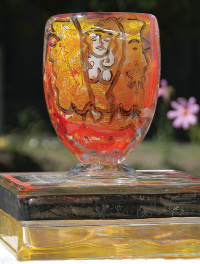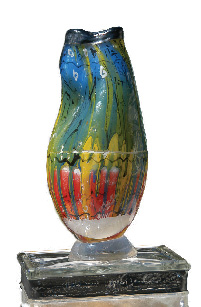- Home
- Media Kit
- Current Issue
- Past Issues
- Ad Specs-Submission
- Ad Print Settings
- Reprints (PDF)
- Photo Specifications (PDF)
- Contact Us

![]()
ONLINE

The Business of Art
Editors' Note
Having branded his mastery of the techniques and influences of the French Modernists, painter and sculptor Howard Lamar incorporates into his artwork a unique language of his own: individually developed and trademarked icons. Lamar continues to develop his artistic exploration in the traditional disciplines of painting and sculpture, and more recently, into the painting of both handblown and architectural glass.
Company Brief
The artist Howard Lamar (www.howardlamar.com) works from a private atelier in Santa Barbara, California. Over 5,000 of his etchings, drypoints, serigraphs, stone lithographs, drawings, watercolors, pastels, and oils have been purchased by prominent collectors worldwide.
Where are you focusing your creative efforts today?
I’ve been driven in a parallel movement, which is to develop a long-held fascination with both the business and the aesthetics of art, and I am devising ways to effectively merge those two worlds.
Over the years, I’ve received immense criticism because if one talks about the selling of one’s artwork, people relegate the status of one’s work to being “commercial” art, rather than “fine” art. At the same time, while private and philanthropic funding for the arts is dwindling, fine art is becoming an increasingly successful and appealing tool for private and corporate investment and wealth preservation. These days, a viable career as a living artist requires the knowledge of both your product and your market, and paying full and balanced respect to both.

Painted Lady (glass)
You were originally focused specifically on painting?
While I did start with painting, I soon got fired up to do sculpture, as I was fascinated in dealing not only with color and line, but with form, as well. Currently, I am in the midst of producing and developing pieces that incorporate line, form, color, and light into sculpture using various combinations of stone, glass, and ceramic elements.
Where did the focus on glass come from?
My son had studied in New Zealand under a master glassblower. Upon his return to the States, he, his brothers, and I began developing blown glass as a family collaboration. Recently, I have expanded my explorations with glass. While I consider myself first and foremost a fine artist, the possibilities within the realm of architectural glass are vast.
Does technology play a role in the way you are producing in any of those areas?
Technology has begun to play an increasingly pivotal role in allowing me to actualize my artistic vision. Many of my new glass, sculpture, and ceramic ideas are on a monumental scale, sometimes requiring specialized tools and techniques. Also, I’m fascinated with laser technology, and especially laser with glass – not so much the cutting of the glass, but the relationship of laser and light, because the more energy and light I can get into the glass, the better.

Opaque Reality (glass)
Technology also comprises a critical element in the development of patentable processes, which are mandatory for the protection of the stylistics and the composition of my art, as well as for defining and protecting new business opportunities.
Do you work across different segments at one time or are you focusing more on one segment at a time?
I am increasingly interested and challenged by what I see as infinite creative possibilities, both in the execution of the art and in the structure and development of the business. It is almost impossible for me to limit myself to one segment at a time; they are all interlaced and effect one another, so much so, that my collaborative partners now include a master ceramicist and a master jeweler, with constant development of both new artistic concepts as well as new products.
How much of a focus has the corporate market been for you, and do you foresee opportunities in these different segments to build the business with corporations?
It is a primary focus. Initially, my work was being purchased for private collections through the CEOs, CFOs, and presidents of various companies. These days, my patrons are making the leap from collecting privately to establishing and expanding corporate fine art collections.
In my conversations with top-level executives, I find enormously creative thinking. The correlation among creativity, innovation, and effectiveness has sparked me strongly into forging my own business; I realized that if I could apply to business what I was doing in art, my business could become as orderly and aesthetically right as my art.
How do you get the message across about what you do, and are you satisfied with the way you’ve built the understanding of your work?
I’m more deeply exploring relationships with established patrons, many holding high-level positions within their companies. These alliances develop naturally, as we have a shared clientele, as well as a focused commitment to the arts, to community, and to humanitarian efforts.
When you look at the work you’re doing across these segments, especially with the painting, where do the ideas come from?
That proverbial lightbulb comes on, and I just see it; then, I have to work my butt off to figure out how to do it. That’s what takes all the time – especially if I’m doing something I haven’t seen or done before.
Do you ever look back on the past or is it always looking ahead?
The evolution of my work is one of continual unfolding, and if I’m lucky enough, I catch insights into it. I can‘t help but do what I do – I am an artist and that’s the way it is. So, the reflection part is extremely important, but I work hard at not being stuck there.•